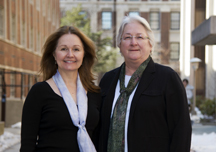Purdue Stuttering Project receives $3 million research grant
April 8, 2013
 |
|
Purdue
University professors Christine Weber-Fox (left) and Anne Smith received a $3
million grant from the National Institutes of Health to understand why some
children grow out of stuttering. Weber-Fox, a professor of speech, language and
hearing sciences and a cognitive neuroscientist, and Smith, a distinguished
professor of speech, language and hearing sciences, lead the Purdue Stuttering
Project. They will use their findings to develop a speech therapy screening
tool to better identify which preschool children are not likely to recover and
should receive therapy immediately. (Purdue University photo/Mark Simons)
|
WEST LAFAYETTE, Ind. — Two professors leading the Purdue Stuttering Project have received a $3 million grant from the National Institutes of Health to understand why some children grow out of stuttering. They will use their findings to develop a speech therapy screening tool to better identify which preschool children are not likely to recover and should receive therapy immediately.
"Speech therapy resources are not necessary for every young child who stutters, but the 'Let's wait and see' approach is missing children who could benefit from early intervention," said Anne Smith, a distinguished professor of speech, language and hearing sciences. "A diagnostic test battery also could help the clinician prepare the best treatment approach, and the earlier treatment begins, the better, because it is easier to learn new patterns of speaking at a younger age. Stuttering often affects many important aspects of life, including social interactions, educational performance and ultimately employment opportunities."
The award funds a five-year project, and professors Smith and Christine Weber-Fox will follow 100 children who stutter, first seen at ages 4-5, over five years. In the first year, the children will complete both standardized and physiological tests of motor, language and emotional development. At the end of the project, the research team will compare the scores on these tests for the two groups of children - those who are still stuttering and those who have recovered. These early test results will then be the basis for deciding which tests to put in the clinical battery to detect a high risk for chronic stuttering in preschoolers.
Five percent of preschool-aged children stutter. Stuttering can be seen as involuntary hesitations, sound prolongations or repetition of syllables in speech. About 75 percent of preschool children will grow out of stuttering, which is found in all cultures. About 1 percent of the world's adult population stutters.
This research, which began with Smith in 1988, has been funded by the NIH's National Institute on Deafness and Other Communication Disorders for more than 25 years and has received more than $13 million in grant awards.
"Purdue's program in speech, language and hearing sciences is nationally ranked and known, and the work led by professors Smith and Weber-Fox contributes to that recognition," said Purdue President Mitch Daniels. "This project is a great example of how research can lead to greater understanding and a tangible resource that parents will benefit from when they are faced with the question of how to help their child."
Smith and Weber-Fox, a professor of speech, language and hearing sciences and a cognitive neuroscientist, have been working together since 1999 and have found there is a difference in brain functioning for people who stutter. These differences appear in people who stutter whether they are talking, listening or silently reading. The researchers have looked at brain activity and motor coordination for adults and children, but have most recently focused on preschool children and the differences between children who recover from stuttering and those who do not.
"We see that children whose stuttering persists also lag in development on speech sounds, speech motor coordination and brain functions for processing language, but more research is needed to identify how measures like these can serve as predictive factors that can identify which children who stutter will recover or persist," Weber-Fox said.
A new area of the project is to examine emotional aspects of stuttering children.
"It has long been known that anxiety about speaking situations is an important aspect of stuttering in adults, but we really do not know if worrying about their 'bumpy' speech is an important factor for little kids," Smith said.
To help look at these emotional factors, Donald Lyman, professor and director of clinical training in psychological sciences, also is collaborating on this project. Lynam's area of focus is in juvenile psychopathology and personality. Also collaborating on the project is Sharon Christ, assistant professor of statistics and human development and family studies.
Writer: Amy Patterson Neubert, 765-494-9723, apatterson@purdue.edu
Sources: Anne Smith, 765-494-7743, asmith@purdue.edu
Christine Weber-Fox, 765-494-3819, weberfox@purdue.edu
